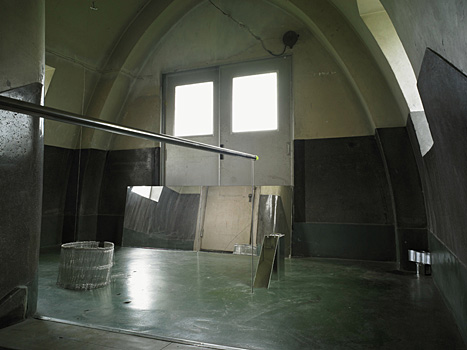

[Treading]@@ϊ{κ
2008
metal,mirror,photo,other,sound 50min
4.6~5~Vm
Sustainable Art Project,Sakamoto primary school,Tokyo
2008.10.18-11.8
Photo:YAMAMOTO Tadasu
[The place, the word, and the body -About the woof-]
The sound played here is the sound of the weaving machine of TSUBASA studio in the Taito welfare hall.
Their colourful textiles are woven by the "SAWORI" weaving method which enables everyone there to weave
readily. As long as the warp yarn is set in the right position, any woof yarn can be used to
weave a fabric.Even if there are some errors in it, they will be interwoven as a part of the pattern.
The weaving machine is modified to suit each user's needs; those who cannot use their hands use their
feet to weave, while those who cannot use their feet attach foot-weight weights to the machine to weave.
What caught my eye was the bags and water-filled plastic bottles which were used as the weights for those machines.
Together with other experiences there, from the perspective of a sculptor I began to observe the people with
disabilities with curiosity.I observed each individual's unique movement and eye level caused by his or her
disability. However, I came to realise that each individual was very different although they were bundled
together and called "people with disabilities" as if they were all the same, and that I too was no exception, of course.
The people who frequent the studio understand the difference of everyone's disabilities well, talk to each other
and act with each person's sense of time.
How does each individual move with their unique human form ?
How are the colour of the woof, the material, and the pattern to weave chosen?
When does it become a 'work'?
I am not too certain whether a good relationship can be built between the art and the people in town.
Also I am not too sure about that the art fits into the rules or expectation of the public.
Is it possible to say that the world of art and the world that I feel outside of it are the same?
Is it possible for art to go beyond social contexts such as politics, economy and race?
Although I think that all these are not central to the concerns of art.
KAGABU Shiho
2008.1O


